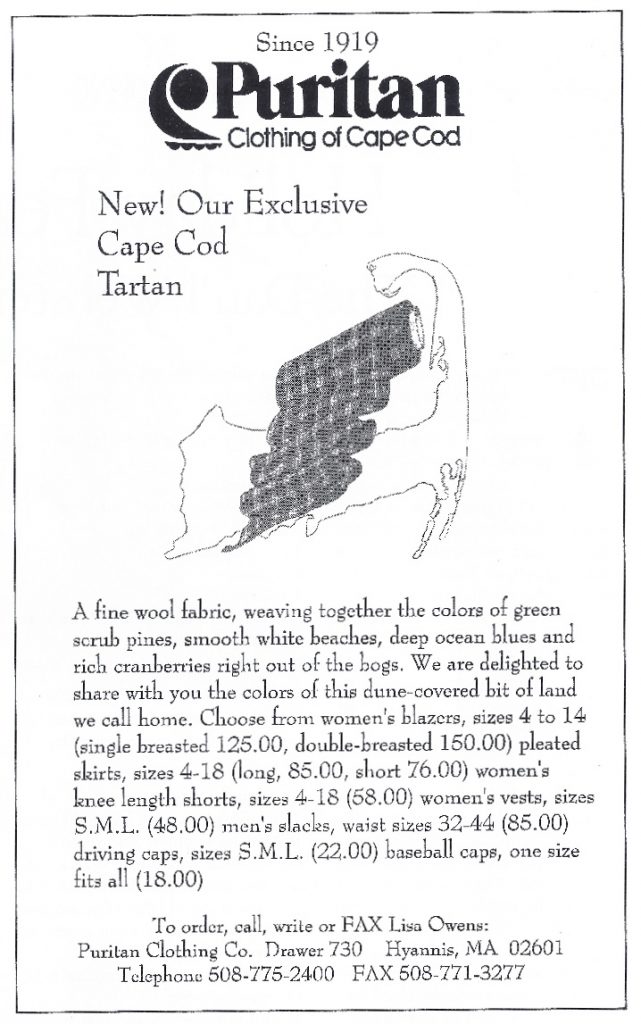Today, in honor of International Tartan Day, associate editor Chris Sharp shares another tale of sartorial esoterica.
* * *
Three thousand thirty-three miles separates Cape Cod from Scotland, yet this dune-covered land has its own tartan. You will not find it in any official tartan registry, but it was once one of the items offered by prominent peninsula outfitter Puritan Cape Cod.
Puritan Cape Cod has been a part of cape life since 1925, but it was 64 years before the Cape Cod Tartan was born. The tartan was the vision of Milton L. Penn. Known now as a dapper nonagenarian and Puritan’s elder statesman, Penn was actively involved in merchandising, buying and marketing for Puritan when the tartan was created.
“In the early 1990s plaid was popular,” Penn tells Ivy Style. It was during the winter of ’91 when Penn was on his way home from a buying trip that he conceived the Cape Cod Tartan. The tartan would be rendered in four colors, each representing a feature of the Cape Cod landscape.
A 1993 advertisement in Cape Cod Life magazine describes the tartan as a “fine wool fabric, weaving together the colors of green scrub pines, smooth white beaches, deep ocean blues, and rich cranberries right out of the bogs.” The wool was produced in Rhode Island by the now defunct Worchester Mill, and the wool was used in a host of women’s items. Men were left with trousers, driving caps and ball caps. “We had a double-faced Portuguese cotton flannel produced also that we used for neckties,” remembers Penn. That tie was made in the US by the Boston firm of Joe Price & Son.
Penn intimates that the tartan was both commercially successful as well as embraced by the Cape Cod community, as evidenced by a request to have it be part of a tartan blessing ceremony. The Cape Cod Tartan items were sold for four years, Penn recalls. One can blame macro-fashion trends for their disappearance. Tartan is just “not as popular anymore,” says Penn.
The Cape Cod Tartan endures in memory and in the wardrobes of those the Penn family outfitted. Like most of the kit we cherish, there is a quixotic self-satisfaction in being a keeper of the flame.
So I will slip into a Chipp jacket rendered in a T. Addie & Sons Shetland, don an old Cape Cod Tartan tie, and nurse a single-malt scotch in the full knowledge that not a soul will ask me about my tie.
If they did, I would smile ever so slightly, buy them a drink, stare across the abyss of 25 years, and tell them the story of how the character of Cape Cod was captured in cloth. — CHRISTOPHER SHARP













I take it this is no longer available from Puritan. Regrettable
Puritan Tartan Crucible making America Great Again.
Great story, I own a tartan tie given to me by my grandmother. The tartan is that of her family’s, it’s nice to have a connect to a tartan.
Reminds me, I visited Puritan and Murray’s last summer and both carry similar clothing. Modern classic and a lot of this brand called “Peter Millar” I keep seeing around.
It’s only a matter of time till Christian and his minions peddle a registered Ivy Style tartan tie on us for fall. 😉
It looks like a cross between Brooks Brothers’ signature tartan and the famous Barbour tartan. I’ve never been a fan of the Burberry tartan though.
I enjoy learning of these little local sartorial histories, thank you.
In some corners of the tradosphere, there is a campaign to “ban the tartan.” It is, after all, a long standing symbol of anti-imperialism, the SNP (cultural Marxists) and the alien culture of Gaelic clans.
The measure was tried in the UK. It worked for a while until the Whigs repealed it. Not shockingly, once the Scots were again allowed to wear their tartan, they began flooding the towns of Northumberland. I hear that Newcastle is now almost entirely pagan and all signs are posted in both Gaelic and English.
nice tie
As a proud Scottish-American, I am forced to protest this cultural appropriation!!!
Preppy SJW
Well done!
But this culture appropriation thing has got me worried, who invented underwear and pants?
If we really took cultural appropriation seriously, anyone who isn’t a native Westerner/European shouldn’t wear suits. They originated in Europe, so the stupid rule of “you can’t wear something that isn’t from your culture” would have made Japan’s love of Ivy offensive. How ludicrous.
Well, we all know it only works one way.
Stupid example. The British established the suit as a business norm throughout their empire. Other cultures who adopted the lounge suit did so to acquiesce to the norms set forth by colonial governors. It’s not really appropriation when it’s something you’re required to wear. Try again.
Tailspin, I am not defending cultural appropriation, but thank you for the history lesson. I agree with Christian that it only works one way, it wouldn’t be deemed acceptable if white people wanted to wear clothes from Japanese culture. Japan’s love of American clothes would be deemed cultural appropriation as Ivy Style is not a part of their culture. They loved the American look and adopted, or appropriated, it. I hate the idea of cultural appropriation and find that if one wants to copy a element from another cultural it is a form of flattery.
*culture
I know you’re not defending cultural appropriation. You’re criticizing it by making a false equivalency, which is even worse.
Japanese people wearing American clothes and adopting some forms of American culture is cultural appropriation. However, the only valid CA, according to the left, is when white people appropriate the cultures of others. It sounds like you’re defending cultural appropriation which is far worse than any of my comments.
You keep using that word. I do not think it means what you think it means.
It’s not appropriation when the owner is encouraging or enforcing the use. Remember how we occupied Japan and encouraged westernization of the culture?
Do they teach logical reasoning in colleges anymore?
“Cultural appropriation is the adoption or use of the elements of one culture by members of another culture.” They adopted American culture, making that a textbook definition example of CA.
I don’t believe that in America’s westernization of Japan we told them how to dress. I believe that that came later as a love of our culture and then adoption. And no they don’t teach logical reasoning in colleges anymore, not since the lefties started controlling them.
Strawman. That isn’t what liberals find objectionable about cultural appropriation. If you want to fight liberals, you need to argue against their actual beliefs. They find it objectionable when it’s taken in a disrespectful manner or against others’ wishes. If you believe that anyone should be able to use other cultures regardless of intent or context, then argue that point.
And yes, of course we told the Japanese how to dress. Business suits were required for conducting business with the occupying authorities. We also sold them the clothing.
Googled for some background and found this:
The appearance of Western clothing and fashion during the Meiji era (1868 1912) represents one of the most remarkable transformations in Japanese history.
Since the United States’ 1854 treaty allowing commerce, negotiated by Commodore Matthew Perry, the Japanese have enthusiastically and effectively borrowed and adapted styles and practices from Western countries. Until then, Japan had isolated itself economically, politically, and culturally from the West as well as neighboring countries for two hundred years. The new Meiji era heralded hope for the future, and government officials felt change necessary for the system to quickly convert Japan into a modern state. Emperor Meiji instituted a parliamentary form of government and introduced modern Western educational and technological practices. The Japanese were then exposed widely to Western influences, and its impact on people’s lives has been impressive. This new modern phenomenon encouraged and expedited the spread of Western clothing among ordinary people, and it became a desirable symbol of modernization.
It was first adopted for men’s military uniforms, with French- and British-style uniforms designed for the army and navy, as this style was what Westerners wore when they first arrived in Japan. Similarly, starting in 1870, government workers, such as policemen, railroad workers, and postal carriers, were required to wear Western male suits. Even in the court of the emperor, the mandate to dress in Western clothing was passed for men in 1872 and for women in 1886. The emperor and empress, as public role models, took the lead and also adopted Western clothing and hairstyles when attending official events, and JAPANESE FASHION 260 Children in traditional Japanese costume. During the Meiji period, the T-shaped kosode became known as the kimono, and it is now recognized as the national dress of Japan. The hakama, as worn by the young boy, can be worn as an outer garment over the kimono.
Japanese socialites were also participating in lavish balls in Western-style evening gowns and tuxedos. By the 1880s, both men and women had more or less adopted Western fashions. By 1890, men were wearing Western suits although it was still not the norm, and Western-style attire for women was still limited to the high nobility and wives of diplomats.
And:
It was during the Meiji period (1868-1912) that Japanese were first widely exposed to Western influences. By the 1880’s both men and women had adopted Western fashions. Western dress came to be seen as synonymous with modernity and many people adopted yofuku (western clothing). In the 1890’s, western suits were the norm for men; however, the Japanese women reverted to traditional Japanese clothing or wafuku. The only women who still wore Western fashion were the high nobility and wives of officials in foreign office. However, 40 years of Western fashion could not help but subtly influence the manner in which the kimono was worn. It unconsciously proclaimed Western elements while at the same time proclaiming its Japaneseness.
Western fashion influenced women’s kimono in two ways. The first is more obvious and relates to the adoption of physical items of dress such as coats, shawls, veils and jewelry. The second is more subtle; it changed notions of feminine beauty, caused the cultivation of clothing sensitivities, and promoted ideological aspirations concerning women in society.
The ideal body of the Western woman in the 1890-1900s was the S-curve. The corset compressed the waist, and caused the bosom to thrust forward and the hips back. The bustle accentuated the shaped behind, and the monobosom balanced it in front. This curvaceous form seems the opposite of the kimono’s straight lines. However, a very subtle penetration of this idealized form did occur in the shape of ladies’ wafuku even as Japanese women determined not to wear Western style dresses. During this time period, a boxy style of obi came into style, which if worn low, resembled a large, attached bustle. Thus, the kimono silhouette was very similar to the idealized Western silhouette.
During the Taisho period (1912-1926) wearing Western apparel again became a sign of Western learning and an expression of modernity. Men began wearing business suits, which after W.W.II became commonplace for working men.
I do believe that people should be allowed to dress as they please even if they wish to adopt another culture’s style. I don’t think that borrowing elements from another culture should be done with an intent to insult or mock. But I still say dress as you please, it’s your life. I tried to use the Japanese using American culture as an example of CA, which clearly provoked you. That was not my intent. Then again, you could have told me why I was wrong in a polite and civil manner. Either way I’m glad I learned something.
But it is interesting to note that in the information provided by Christian that the Japanese people only opened up to western ideals and customs due to a commerce deal. They were isolated and then when America made a deal with them they were fascinated by the different, Western culture and adopted it. The Americans didn’t barge in and demand that they conform and wear suits, they met the Americans and liked and copied their ways. Much like Catherine the Great who greatly transformed Russia through French influences, and essentially borrowed from another culture to add to her own. It all sounds like cultural appropriation to me, which is a thing to be celebrated.
I think both GS and Taliesin are missing some nuance. First, the Japanese likely, to some extent, adopted western dress as a sort of “price of admission” for trading with the west. It seems unlikely that western businesspeople and dignitaries would take the Japanese seriously if they did not present themselves in western dress. I am operating on the assumption that everyone agrees that, by the 20th century, western business dress was the de facto standard. Thus, adoption of western business norms would be acquiescence, rather than appropriation.
Second, even if the Japanese adopted western dress purely for aesthetic reasons, I think we can all agree that they developed an intimate knowledge of western traditions and their execution was respectful to those traditions. This is what sociologists call “cultural exchange” rather than appropriation. It is generally looked at as a good thing.
An appropriate example of cultural appropriation from a white source would be the contemporary American celebration of St. Patrick’s Day. It is generally celebrated in a manner that lacks significant understanding of the tradition or why it is important to Irish Catholics. It also emphasizes the worst stereotypes about the Irish (that they are drunkards). Contrast that with the relatively nuanced and detail-oriented adoption of American clothing by the Japanese.
I suspect that GS may not be as against the left as he thinks. Much of the conflict over this issue appears to be the result of a misunderstanding between the right and the left. A lot of what the right derides as “political correctness” is not really a new concept. It used to be known as simply “polite manners.”
Thank god we have today’s campus protestors to defend polite manners.
I’m not sure your snark helps much either.
And besides, means and ends are different things. The tactics of a small minority of anarchists don’t have any bearing on the merit of the underlying ideas. I’m sure you wouldn’t want your ideas to be judged by the manner in which the the Milo Yiannopoulos brigade conducts itself.
And yet the mainstream left seems to have trouble condemning this “small minority of anarchists” that seem to be everywhere.
https://www.youtube.com/watch?v=snqXOvnHzcQ
“They won’t say anything [in defense of free speech etc.] because of a kind of shaming that right now the Left tends to specialize in…”
Haidt with Sam Harris:
https://www.youtube.com/watch?v=OI0lG4PEMkw
Actually, plenty on the left are happy to disavow that behavior. Bill Maher, Kirsten Powers, Sam Harris, Stanley Fish, Nicholas Kristof, Dick Durbin, and Peter Beinart are just a few who have denounced campus violence.
That being said, we should remember that absolute free speech on campus is not desirable. I defer to Stanley Fish’s argument that freedom of speech and freedom of inquiry are entirely different creatures. Academies must have the right to constrain the conversation. If they cannot, there is no purpose for accredidation, peer review, or even professors themselves. An academic community must have the power to edit out what it considers bad perspectives, methodologies and ideas.
In the case of public universities, which are bound by the First Amendment, the scope should obviously be wider. However, a private college like Middlebury must be allowed to constrain the conversation as it sees fit, or there is no freedom of inquiry.
And it cuts both ways. The academic communities of Liberty, Bob Jones, Regent, and to a lesser extent BYU, George Mason and Pepperdine, restrict the availability of ideas on their campuses and students who wish to be taught from those perspectives are certainly free to attend those colleges.
I don’t think there are many free speech purists on the right out there. If there are, I don’t see them condemning the practices of the above institutions. Nor do I see them condemning the incredible assaults on press freedom and political satire leveled by Donald Trump. Even the National Review, which routinely criticized Trump on free speech grounds in early 2016 went silent on the matter once he won the Republican nomination. Nor do I see conservatives denouncing Glenn Beck’s dismissal of Tomi Lahren because she didn’t tow the party line.
I’m happy to have a conversation about ideas. Unfortunately, you seem to only want to go after low hanging fruit.
That fruit is so ripe for the picking.
It’s also lazy. I get that your blog is your business and you rely on clicks for advertising revenue. I get that clickbait translates into more advertising revenue for you. You have the right to run your business as you like.
But know that if you are going to keep picking the low hanging fruit, you are just as responsible for the rotting of minds as Jezebel and Buzzfeed (even if you rot the minds of a smaller niche).
At least drop the smugness. It reeks of sad insecurity.
How about a band-wagon we can all jump on? Let’s pile on Master Fecalberry, I mean F.E.Castleberry!
I had to scroll back to the top to remind myself just what the original topic was. Thus the convoluted rabbit hole of today’s thought process. It seems every topic must be filtered through political banter. Sad!